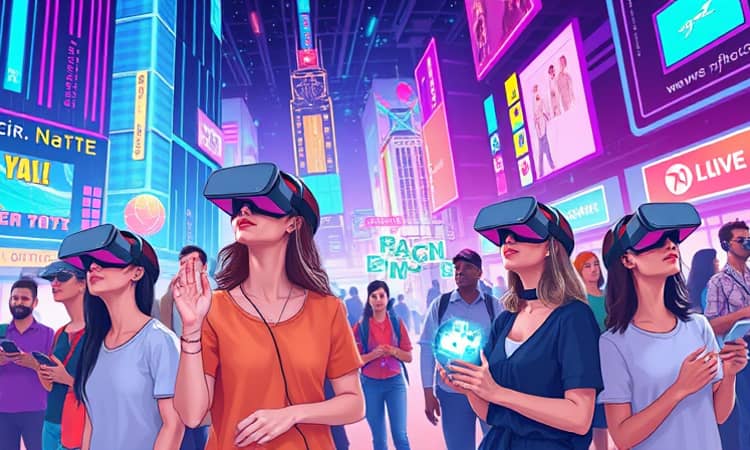In a world where screens define our experiences, entertainment is undergoing a profound metamorphosis. Once characterized by passive consumption—tuning in, clicking play, and watching—today’s audiences crave connection, creativity, and agency. From the electric hum of a VR headset to the collective thrill of a global e-sports tournament, entertainment has become an immersive stage where every individual can play a role.
This evolution transcends mere novelty. It represents a deep-seated human yearning to influence stories, shape outcomes, and connect with others in meaningful ways. As technology and imagination converge, interactive entertainment emerges as a powerful catalyst for cultural dialogue, personal growth, and communal joy.
Market Growth and Shifting Preferences
Behind this cultural shift lies staggering economic momentum. The global online entertainment market was valued at USD 522.1 billion in 2024, with forecasts projecting an extraordinary climb to USD 2,184.7 billion by 2033. Such expansion corresponds to a 17.24% compound annual growth rate, reflecting both technological advances and consumer enthusiasm.
North America leads the charge, claiming 45.6% of the market, propelled by robust internet infrastructure, widespread 5G adoption, and a voracious appetite for on-demand content. Yet similar patterns are emerging across Europe, Asia-Pacific, and Latin America, as localized platforms and homegrown creators tap into global networks.
Amidst this growth, immersive and interactive experiences are supplanting passive viewing. Recent studies show 90% of consumers actively seek content that responds to their actions, while traditional Pay TV subscriptions in the U.S. continue a steady decline, expected to fall below 50 million by 2025.
Driving Forces Behind Change
The shift toward interactive entertainment is fueled by an intersection of technology, psychology, and market dynamics that together redefine how stories are told and experienced. Key trends illustrate this seismic transition:
- Experiential entertainment is revolutionizing the industry, with theme parks, branded districts, and live performances offering multi-sensory narratives where attendees become active participants.
- AI integration elevates personalization, from generative photo booths crafting custom portraits to dynamic content algorithms that adapt to individual preferences in real time.
- Multi-sensory activations ensure messages resonate by weaving sight, sound, touch, and even scent, creating unforgettable emotional imprints.
- Gaming evolves as a social epicenter: nearly half of young adults report forging lasting friendships online, while 40% of Gen Z and Millennials engage more in virtual worlds than in person.
- Location-based entertainment unlocks new revenue with low capital intensity, transforming popular intellectual properties into immersive in-person journeys.
These trends underscore a collective craving for experiences that stimulate the senses and engage the mind, fostering loyalty far beyond traditional advertising or storytelling.
Innovative Forms of Interactive Content
As creators push boundaries, diverse formats emerge to captivate and involve audiences. Interactive content no longer lives on the fringes—it is central to marketing, education, and entertainment strategies across industries. Below are twelve standout forms shaping this dynamic landscape:
- Branching interactive stories that evolve based on user choices
- Personality quizzes that double as engagement and data-gathering tools
- Real-time polls and surveys integrated into live streams
- Interactive infographics that allow users to explore datasets
- Clickable videos linking directly to products in shoppable experiences
- Calculators and custom tools providing personalized insights
- Adaptive ebooks and whitepapers responding to reader engagement
- Serious and gamified apps designed for both learning and enjoyment
- Augmented reality overlays blending virtual elements into real spaces
- Email campaigns embedded with interactive modules
- Interactive webinars encouraging two-way dialogue between hosts and viewers
- Geo-based interactive maps guiding exploration in real and virtual worlds
By leveraging these formats, brands deliver hyper-personalization of entertainment content, resulting in deeper user affinity and measurable increases in conversion rates.
Business Model Evolution and Competitive Landscape
The interactive frontier has disrupted legacy business models, prompting both opportunity and upheaval. Streaming services once reliant on subscription fees are diversifying revenue streams through interactive programming, premium virtual events, and merchandised digital assets.
Meanwhile, independent creators embrace direct-to-consumer models gaining traction, using platforms that let them own distribution channels, harnessing communities directly and avoiding costly middlemen. This democratization empowers niche storytellers to reach global audiences with lean operations and authentic voices.
Advertisers and marketers are gravitating toward interactive campaigns, with 93% affirming their efficacy in educating and converting prospects. Brands that weave interactive elements into product launches, social media activations, and loyalty programs report higher engagement metrics than those relying solely on passive ads.
Traditional Pay TV and cinema chains are at a crossroads: adapt by integrating interactive features—such as second-screen experiences and VR screenings—or risk decline as audiences gravitate toward more participatory, social forms of entertainment.
Technology Enablers and Future Outlook
The backbone of this revolution is a suite of enabling technologies—each pushing the envelope of what is possible and accessible.
- High-speed internet infrastructure worldwide, including 5G and fiber networks, drives seamless, latency-free interactions.
- The proliferation of affordable, high-performance smartphones, VR headsets, and AR glasses democratizes immersive experiences.
- Advances in VR and AR hardware deliver ever-more realistic simulations, shrinking the gap between fantasy and reality.
- Cloud gaming is expanding access, enabling high-fidelity play on everyday devices without costly consoles or PCs.
Looking forward, we anticipate greater synergy between AI and blockchain, where decentralized ownership of virtual assets fosters new economies within interactive worlds. The rise of metaverse platforms promises communal spaces where art, commerce, and education converge in entirely novel ecosystems.
Conclusion: Embracing a New Era
Interactive entertainment is more than a technological trend—it is a cultural movement redefining connection, creativity, and commerce. By daring to innovate and invite participation, businesses can forge tight-knit communities, spark emotional resonance, and unlock sustainable growth.
Whether a seasoned developer, a visionary marketer, or an enthusiastic consumer, the interactive horizon beckons with promise. Dive in, experiment boldly, and discover how transforming passive viewing into participation can elevate storytelling to an art form that resonates across borders and generations.
Together, we stand at the dawn of an era where every click, gesture, and decision writes a new chapter in a collective narrative. The stage is set—will you take your place in this unfolding story?
References
- https://www2.deloitte.com/us/en/insights/industry/technology/technology-media-telecom-outlooks/2025-media-entertainment-outlook.html
- https://www2.deloitte.com/us/en/insights/industry/technology/digital-media-trends-consumption-habits-survey/2025.html
- https://www.alixpartners.com/media-entertainment-industry-predictions-report-2025/
- https://www.bizbash.com/industry-insiders/article/22932501/5-experiential-event-trends-for-2025
- https://www.baeventures.com/en/insights/spotlight-on-2025-trends-shaping-the-future-of-entertainment-and-tourism/982/
- https://www.imarcgroup.com/online-entertainment-market
- https://www.storyly.io/post/types-of-interactive-content
- https://meetglimpse.com/trends/entertainment-media-trends/














